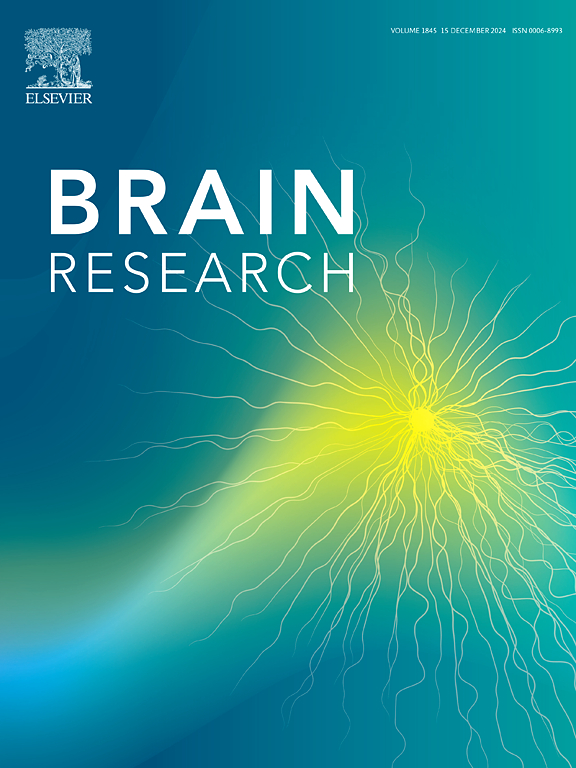原发性开角型青光眼患者的视觉、认知和情绪脑区不规则时间波动。
IF 2.6
4区 医学
Q3 NEUROSCIENCES
引用次数: 0
摘要
原发性开角型青光眼(POAG)现在被视为一种逐渐恶化的神经退行性疾病。先前的神经影像学研究忽略了动态脑活动,在静息状态功能MRI (rs-fMRI)中假设静态模式,而内在脑活动是动态的,随时间波动。为了验证POAG患者脑活动的时变,对70例POAG患者和45例健康对照(hc)进行了rs-fMRI数据的时间动态分析。滑动窗法计算全脑低频波动动态幅值(dALFF),并分析各组差异及与眼科学和神经心理学指标的相关性。多变量模式分析评估了dALFF和静态alff区分POAG患者和hcc患者的能力。与hc相比,POAG患者在视觉网络区域表现出较低的dALFF,而在默认模式、腹侧注意和额顶叶网络区域表现出较高的dALFF。下颌dALFF下降与视野缺损相关。视觉网络dALFF区分POAG患者和hcc的准确率为79.13 %,灵敏度为66.67 %,特异性为87.14 % (p = 0.001)。dALFF的曲线下面积显著大于静态alff (p = 0.026)。POAG患者表现出不规则的随时间变化的大脑活动,特别是在与视觉、运动和情感/认知功能相关的区域。该研究表明,dALFF为捕获异常时变脑活动及其临床关系提供了一种新的方法,具有增强对POAG机制的理解和改进其诊断的潜力。本文章由计算机程序翻译,如有差异,请以英文原文为准。

Irregular temporal fluctuations in visual, cognitive and emotional brain regions in primary open-angle glaucoma patients
Primary open-angle glaucoma (POAG) is now seen as a progressively worsening neurodegenerative disorder. Previvors neuroimaging studies neglect dynamic brain activity, assuming static patterns in resting-state functional MRI (rs-fMRI), while intrinsic brain activity is dynamic and fluctuates over time. To test the time-varying brain activity in POAG patients, a temporal dynamic analysis of rs-fMRI data was conducted on 70 POAG patients and 45 healthy controls (HCs). The sliding-window method calculated dynamic amplitude of low-frequency fluctuations (dALFF) across the brain, and group differences and correlations with ophthalmological and neuropsychological measures were analyzed. Multivariate pattern analysis evaluated dALFF and static-ALFF’s ability to differentiate POAG patients from HCs. POAG patients exhibited lower dALFF in visual network areas and higher dALFF in the default mode, ventral attention, and frontoparietal networks compared to HCs. Decreased dALFF in the cuneus correlated with visual field deficits. Visual network dALFF distinguished POAG patients from HCs with 79.13 % accuracy, 66.67 % sensitivity, and 87.14 % specificity (p = 0.001). The dALFF’s area under the curve was significantly greater than that of static-ALFF (p = 0.026). POAG patients show irregular time-varying brain activity, especially in areas linked to vision, movement, and emotional/cognitive functions. This study suggests that dALFF offers a novel approach to capture the aberrant time-varying brain activity and its clinical relation, holding potential for enhancing the understanding of POAG mechanisms and improving its diagnosis.
求助全文
通过发布文献求助,成功后即可免费获取论文全文。
去求助
来源期刊

Brain Research
医学-神经科学
CiteScore
5.90
自引率
3.40%
发文量
268
审稿时长
47 days
期刊介绍:
An international multidisciplinary journal devoted to fundamental research in the brain sciences.
Brain Research publishes papers reporting interdisciplinary investigations of nervous system structure and function that are of general interest to the international community of neuroscientists. As is evident from the journals name, its scope is broad, ranging from cellular and molecular studies through systems neuroscience, cognition and disease. Invited reviews are also published; suggestions for and inquiries about potential reviews are welcomed.
With the appearance of the final issue of the 2011 subscription, Vol. 67/1-2 (24 June 2011), Brain Research Reviews has ceased publication as a distinct journal separate from Brain Research. Review articles accepted for Brain Research are now published in that journal.
 求助内容:
求助内容: 应助结果提醒方式:
应助结果提醒方式:


